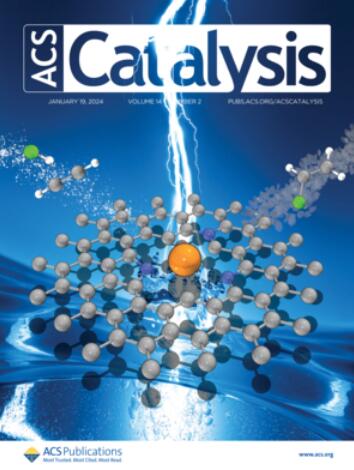Ni-Catalyzed Cyanation of (Hetero)Aryl Electrophiles Using the Nontoxic Cyanating Reagent K4[Fe(CN)6]
IF 11.3
1区 化学
Q1 CHEMISTRY, PHYSICAL
引用次数: 0
Abstract
A Ni-catalyzed cyanation of aryl halides using potassium ferrocyanide (K4[Fe(CN)6]) as a nontoxic cyanide source has been developed. Key features of this method include the use of biphasic aqueous conditions to overcome the innate insolubility of K4[Fe(CN)6] in organic solvents and the use of a bench-stable Ni(II) precatalyst combined with a commercially available JosiPhos ligand that enhances the practicality and scalability of this cyanation reaction. The inclusion of the acidic additive tetrabutylammonium hydrogen sulfate was found to improve the reaction rate and conversion. The initial scope of this Ni-catalyzed cyanation reaction was successfully demonstrated on a range of (hetero)aryl bromides, chlorides, and sulfamates using catalyst loadings as low as 2.5 mol %. This base-metal-catalyzed methodology was further translated to the decagram synthesis of a pharmaceutical intermediate, usurping the prior Pd-catalyzed process that employed a hazardous cyanide source and solvent pair (Zn(CN)2, DMAc).

无毒氰化试剂K4[Fe(CN)6]催化(杂)芳基亲电试剂的氰化
以亚铁氰化钾(K4[Fe(CN)6])为无毒氰化物源,进行了镍催化芳基卤化物氰化反应。该方法的主要特点包括使用双相水条件来克服K4[Fe(CN)6]在有机溶剂中的固有不溶性,以及使用稳定的Ni(II)预催化剂与市售的JosiPhos配体结合,从而提高了该氰化反应的实用性和可扩展性。酸性添加剂硫酸四丁基氢铵的加入提高了反应速率和转化率。这个镍催化的氰化反应的初始范围成功地证明了在一系列(杂)芳基溴、氯化物和氨基甲酸盐上使用低至2.5 mol %的催化剂负载。这种贱金属催化的方法被进一步转化为药物中间体的十元合成,取代了先前使用有害氰化物源和溶剂对(Zn(CN)2, DMAc)的pd催化工艺。
本文章由计算机程序翻译,如有差异,请以英文原文为准。
求助全文
约1分钟内获得全文
求助全文
来源期刊

ACS Catalysis
CHEMISTRY, PHYSICAL-
CiteScore
20.80
自引率
6.20%
发文量
1253
审稿时长
1.5 months
期刊介绍:
ACS Catalysis is an esteemed journal that publishes original research in the fields of heterogeneous catalysis, molecular catalysis, and biocatalysis. It offers broad coverage across diverse areas such as life sciences, organometallics and synthesis, photochemistry and electrochemistry, drug discovery and synthesis, materials science, environmental protection, polymer discovery and synthesis, and energy and fuels.
The scope of the journal is to showcase innovative work in various aspects of catalysis. This includes new reactions and novel synthetic approaches utilizing known catalysts, the discovery or modification of new catalysts, elucidation of catalytic mechanisms through cutting-edge investigations, practical enhancements of existing processes, as well as conceptual advances in the field. Contributions to ACS Catalysis can encompass both experimental and theoretical research focused on catalytic molecules, macromolecules, and materials that exhibit catalytic turnover.
 求助内容:
求助内容: 应助结果提醒方式:
应助结果提醒方式:


